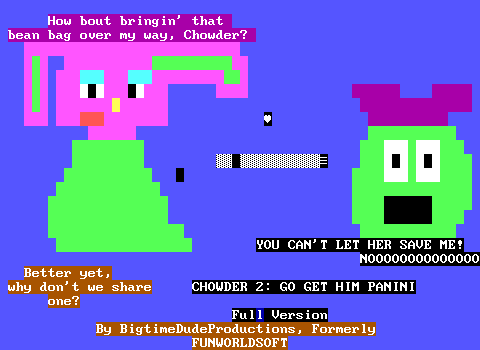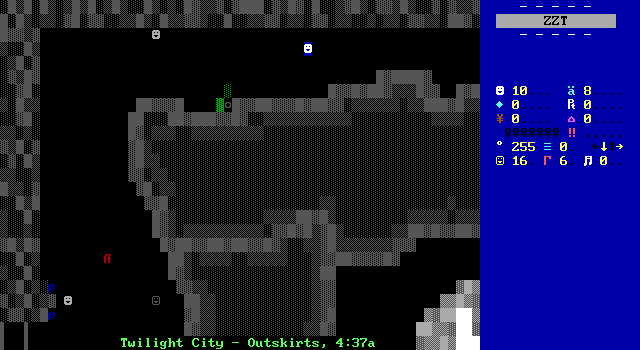City Escape
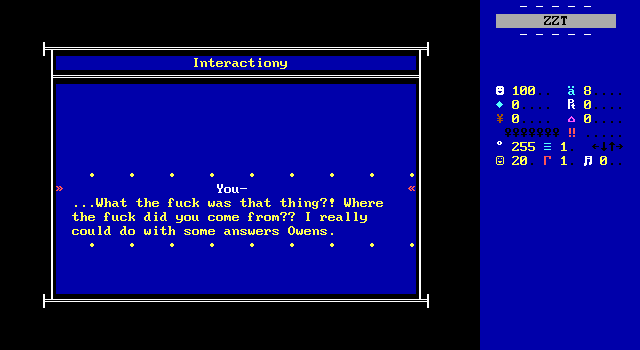
After nearly being killed by his coworker in a state where it's unclear if he's even human still, Riley has a few questions for the guy who also showed up to his apartment at four in the morning. Fortunately, Owens actually has a vague understanding of what's going on. He too felt an urge to return to the labs, but unlike Riley, Owens actually did, allowing him to overhear a conversation between presumably Claire Weston and another unknown individual.
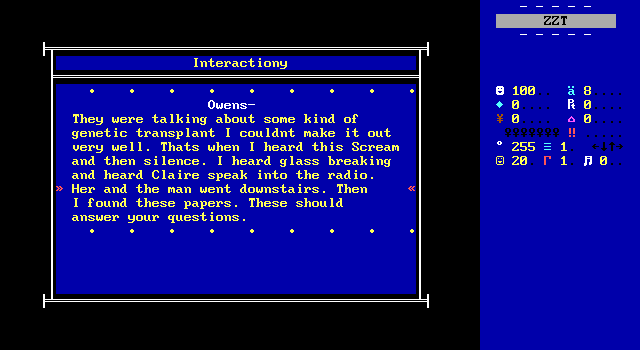
Owens is going to need another new job already.
He places some documents onto Riley's table and tells him to read them. But first, players get to explore Riley's very depressing apartment which has so little in it, that it paints a very grim picture about Riley's life. I'm unsure how much of this is Fishfood having fun with not furnishing a ZZT apartment and how much of it is meant to show just how awful the future (or 1998) will get.
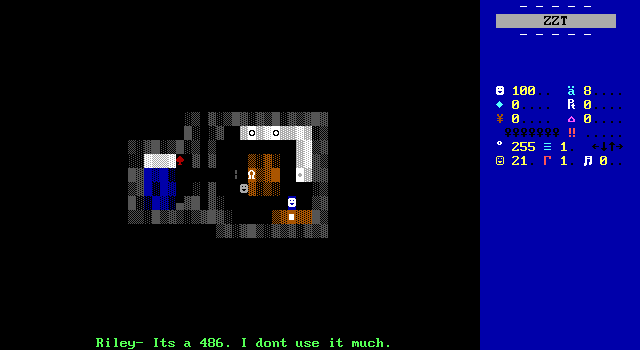
For your sake Riley, I hope it's 1998 and not 2006.
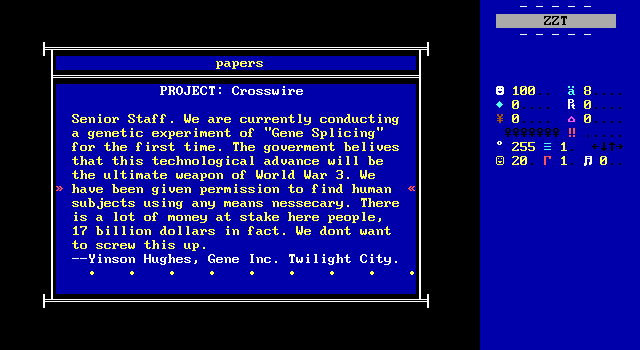
The dubious timeline continues as World War 3 is mentioned alongside Twilight City. More importantly, Mr. Hughes is involved in a gene splicing experiment on behalf of the government, with human test subjects as a key component. More than likely Riley and his fellow new researchers are nothing more than guinea pigs.
The first of the experiments into the
gene splicing theory have begun today.
The first human patient was bought in
by Claire Weston, under heavy drugs. His
name is too remain unknown. After 4 hours
of work, something went wrong and the
man lost all brain power for about 10
mintues. He was dead. Then suddenly -
he rose from the table and ran towards
the elavator. We managed to capture the
man in his zombie-like state and put him
in a cell. The death of the floor 17
secruity guard has been dealt with
promptly.
• • • • • • • • •
The second document somewhat explains the incident at the start of the game, and incriminates Claire Weston. I can't believe Gene Inc. is doing unethical experiments in gene splicing.
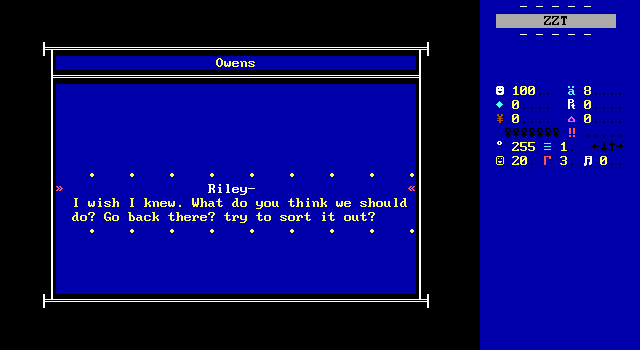
Forgive Riley, he's probably a bit tired after having to fight a monster/man on only a few hours of interrupted sleep. "Sort it out"! What are you going to sort out?!
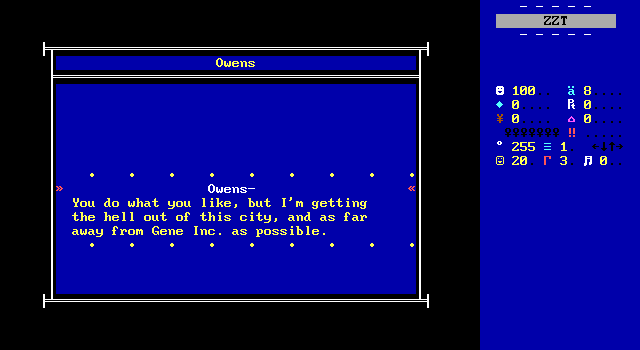
Owens has good sense at least. Just leave.
Riley, on hearing a sensible idea, is immediately on board. He suggests the two head to the subway to take a train to the outskirts of the city right away before "Mohr" returns or anybody from Gene Inc. finds them.

The next passage takes players directly to the station with Owens in tow. I would normally have skipped over this board entirely except it's so ugly that I talked to everyone and waited around for the train to arrive, before finally realizing that the dark gray on the bottom is the train. The passage to the next board stood out, but I was expecting there to be something that had to happen before I'd be able to access it. Not the case. This is merely another soft gameplay board where players have little to do other than walk to the next location.

The subway train does a much better job communicating what it is once Riley boards. The tunnel walls use a moving light effect to convey that the train is in motion, something that was lacking back in the elevator of Gene Inc.
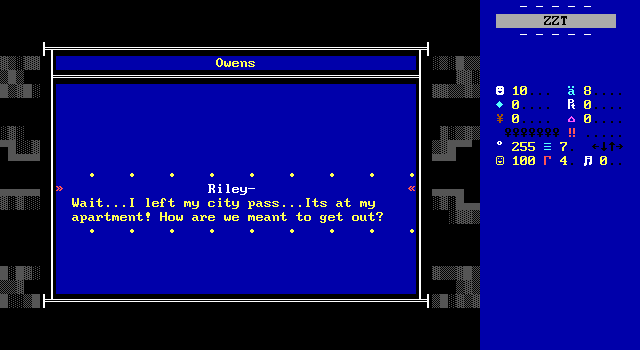
In a moment of panic, Riley realizes he was in such a hurry to escape that he didn't grab his city pass and won't be allowed to leave. Owens calms him by saying that they can travel together, using his own pass with Riley serving as the plus one. Crisis averted. This will definitely not become relevant later.
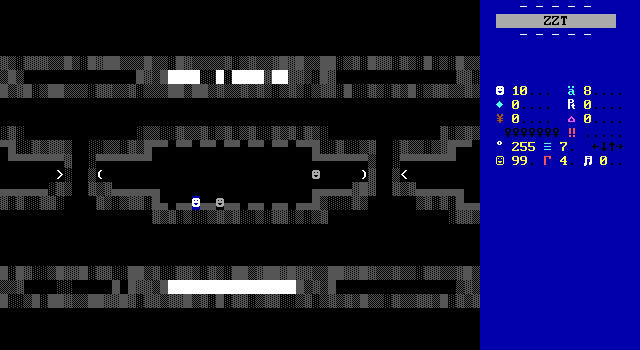
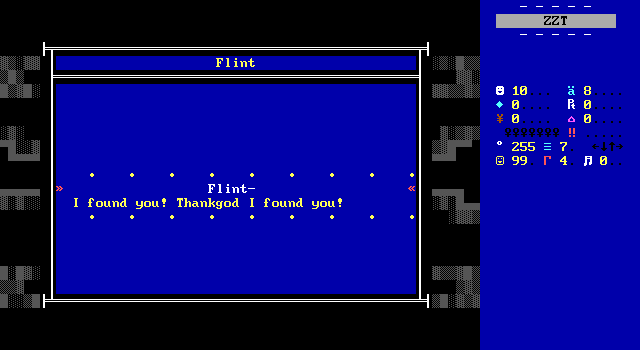
Riley's old buddy Flint shows up from the neighboring car, relieved to have finally found the two. Riley asks if he has any idea what's going on. Flint happens to know quite a bit. Owens is uneasy at letting somebody else join them, but Riley reassures him that Flint is a long-time friend they can trust.
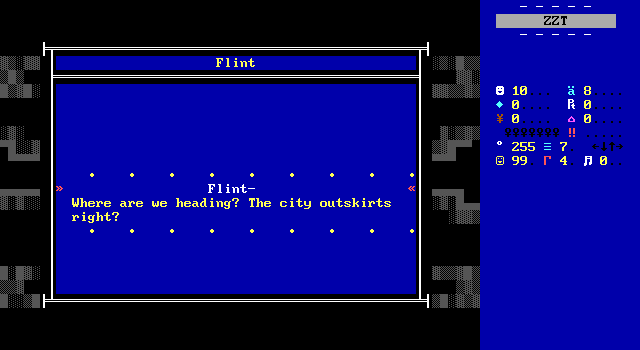
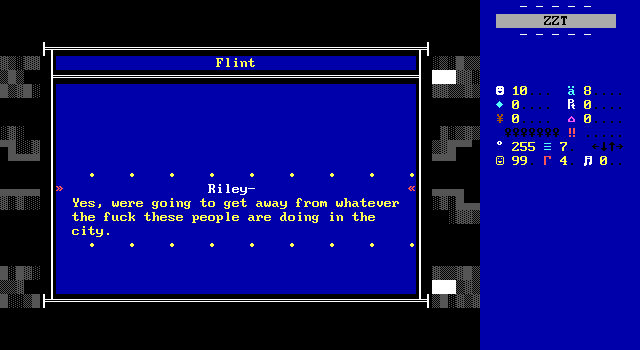

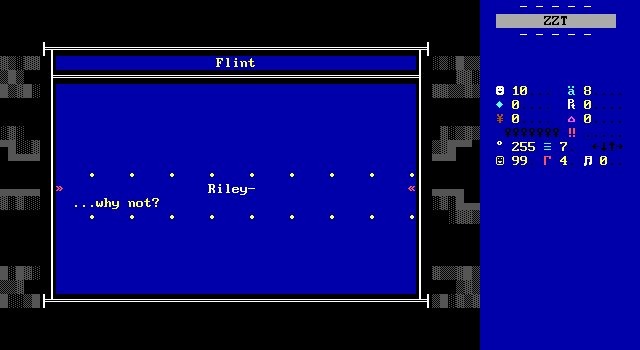

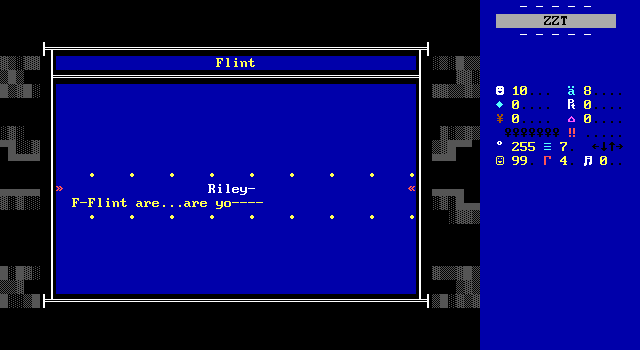
Flint cannot be trusted.
He reveals his true alliance to Gene Inc. These two know too much and cannot be allowed to leave the city.

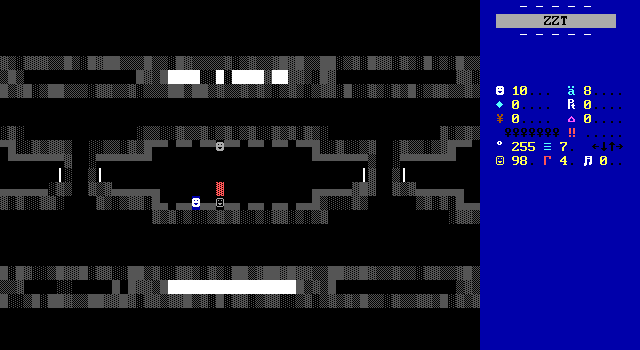
Owens is promptly shot and killed, giving players a moment to react and try and get away.
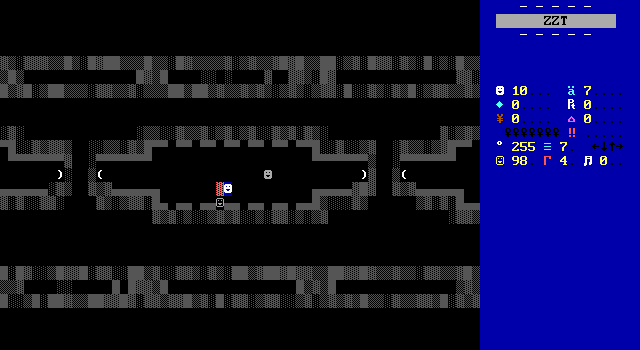
The escape from Flint is kind of awkward. Transporters connect to two train cars providing two potential exits, but though the one on the right is blocked by an invisible object, punishing players that opt for that direction.
The board also quietly sets the player's health down to ten, so if any of Flint's bullets hit you: prepare to die. That's logically consistent with Owens, but ZZT being ZZT, it's not expected that one shot will kill players during a gameplay sequence. I mean, with ten health it is, but the sudden drop to ten comes without warning. This would've been better handled by setting the player's health to ten all the way at the start of the game giving players much more time to notice the lack of health.
Lastly, players retain their ammo from the RPG battle against Mohr. It's not unreasonable to think that that the goal here is to defeat Flint with those leftover bullets rather than to run. Flint cannot be harmed, and offers no reaction to being shot. Not even the classic cop-out "Ha! Bullet proof vest!". Instead players have to determine for themselves that violence isn't the answer here, probably after dying once or twice.
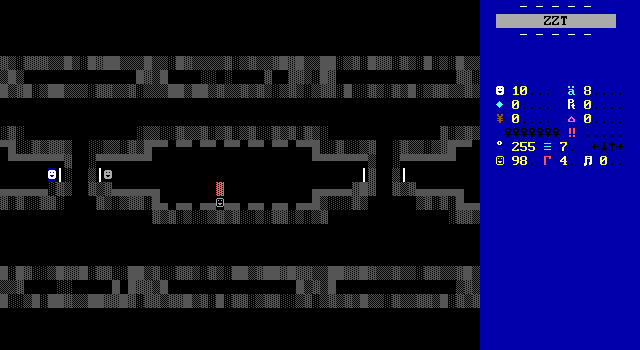
Reaching the transporter is all it takes to get away as objects can't follow. This was an opportunity for me to record the animated lights at least.
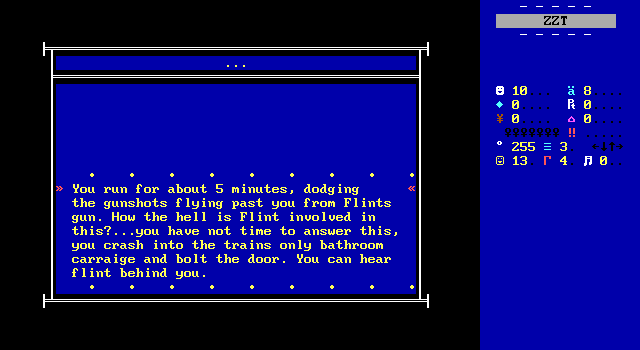
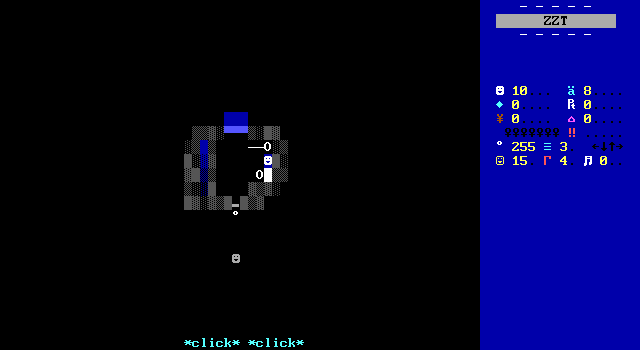
Players are thrust into the train's bathroom where a locked door is once again all the stands between Riley and certain death. Another "puzzle" with finding the right object to survive presents itself, this time in the form of a metal plunger by the toilet that can be used to break the window and leap from the train.
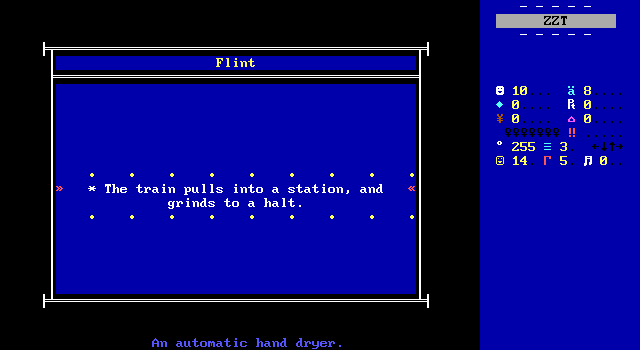
Don't worry. It's not moving any more.
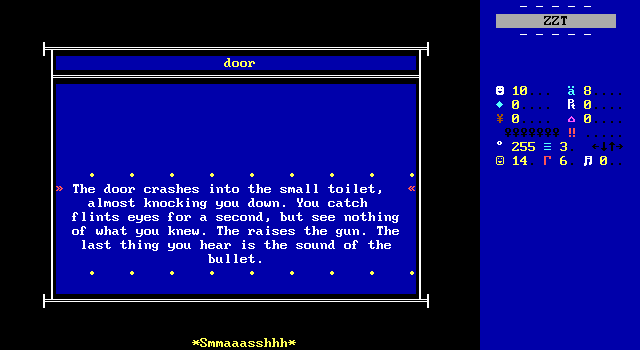
The time limit is short enough that it actually isn't hard to die here. In the game over message, Flint's being "off" makes it possible that whatever happened to Mohr is happening to him too, or perhaps some other form of control not yet explained. It at least makes it plausible that Flint isn't willingly cooperating with Gene Inc here.
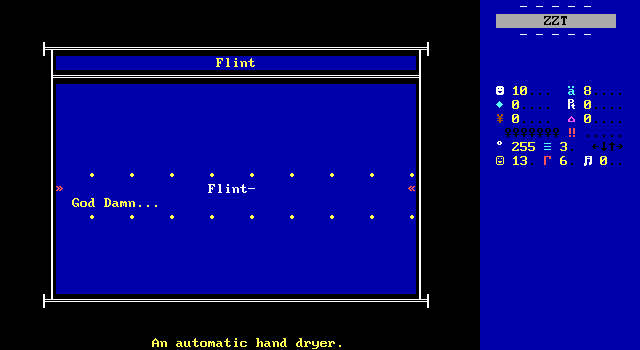
The daring escape works, and Flint is unable to follow, even though this is a regular stop for the train so he shouldn't be too far behind leaving normally. There's probably not much of a crowd before sunrise.
The Outskirts
Can I take this moment to complain about the expanding text? It goes by incredibly quickly making it impossible to get a clean screenshot, and then every single time it lingers on the last character instead of replacing it with a space so you just get a single letter flashing on the bottom of the screen for a bit that ruins the otherwise fancy presentation.
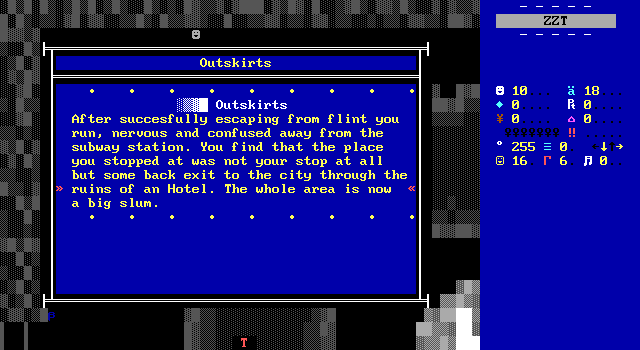
The final chapter of the game is the outskirts. From here, Riley needs to secure his exit.

It's the first look the player gets at Fish's Twilight City during actual gameplay. Gone are the office workers with desk. Instead, the outskirts are filled with people living with squalor who see people like Riley as the reason they have to suffer. Friendly faces are hard to come by with most folks reactions to Riley's presence ranging from telling him he shouldn't be in this part of the city, to telling him to fuck off outright, to attacking him in hope of getting his cash and other valuables.

Despite Riley's gun not being relevant when being attacked by Flint, Fishfood again quietly tweaks the numbers, giving players another ten ammo for this sequence. I'm really not a fan of how this is all silently handled and how whether or not your gun will work in a given situation is entirely up to Fish's whims with no communication to the player.

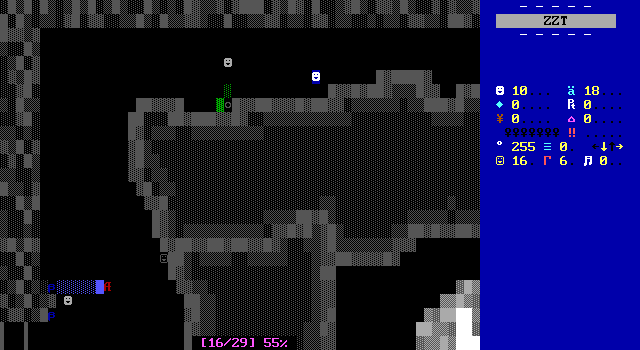
Players are introduced to their next goal immediately. At the bottom of the board is the checkpoint that needs to be passed to leave the city. A stray dog wanders too closely and too aggressively to the guard resulting in a laser blasting them against to the wall, leaving them dead. The oppressive nature of Twilight City really doesn't get explored in detail, so it's just moments like this that have to quickly establish how much of a disregard for life these guards have. Investigating the body gets a bit more explicit about the death. So yes, the dog dies, and in a horrible way.
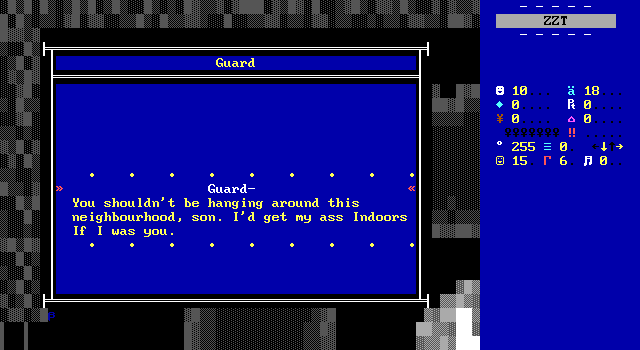
The guard is actually sympathetic to Riley, who probably looks far better off than those who have to live here, though the idea that Riley might want out doesn't even cross their mind.
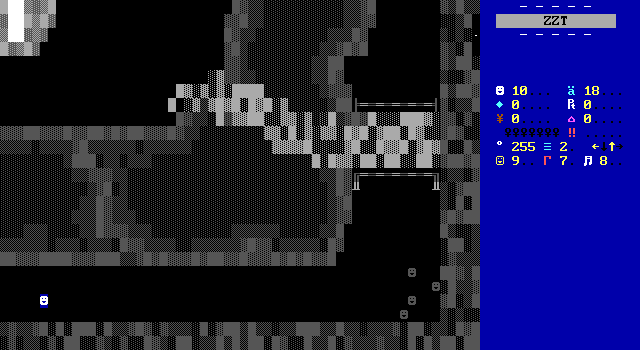
The slums area of Dark Soul are arranged into a small square with an inner and outer barrier of loosely defined buildings. Riley starts in the top left and can go in either direction, though deviating from the proper path only lets him check out littered streets and get yelled at by the homeless.
To advance the game, players need to take Riley south towards the lower right board. Despite the circular arrangement of boards, a raised bridge serves as an obstacle preventing that prevents traveling clockwise from working, and makes the top right board pointless.
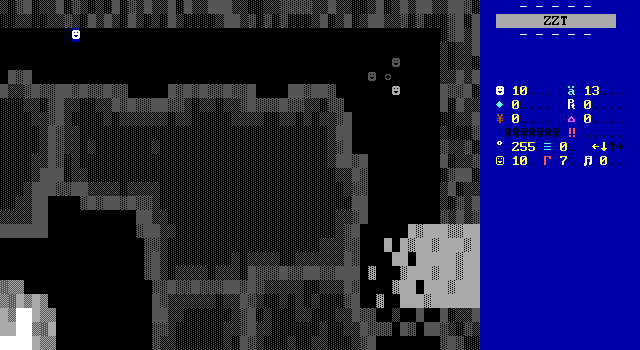
Admittedly, it does let Fish fill out the city a bit more. Whether that's worth making players turn around is difficult to agree with. Nothing about the extra board really adds anything. More likely it exists because the inner walls form something in the middle of the slums that's been precisely positioned to make it difficult to decipher from any individual board. Its purpose will come into play shortly.
The board also features a way back into the city, which Riley rejects any attempts of players to steer them in that direction, reminding them that the goal is out.
business suit?
what Its like down here, you don't have
to sleep on these stinkin' putrid streets
every goddamn night of your life. You
people dont know what poverty is. Now
were about to show you. Get him, boys.
• • • • • • • • •
R-Riley did you put on business attire at four in the morning?
Though, given the difference in how the security guard acted towards him, perhaps it wasn't a bad call.
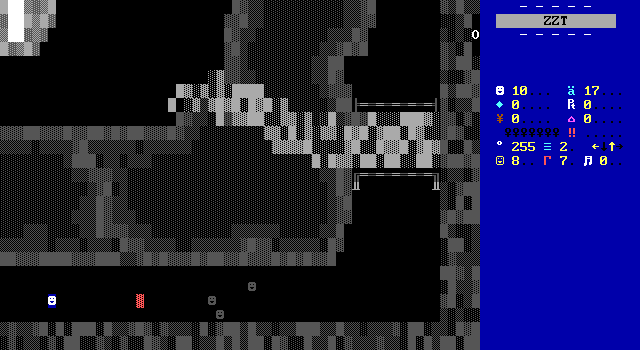
An extremely short action sequence follows with four basic enemies that run in the player's general direction and are taken down with a single shot. As easy as they are, any slip-up will result in instant death. Fishfood didn't bother coding in a nice game over message so the game will just end abruptly if one of the thugs meets you.
The thugs need to all be taken out in order for another object to set up a duplicator-based player warp which also happens without any feedback. Depending on what cycle the last enemy is defeated on, it's possible to have the final bullet strike and for players to be warped instantly.
The duplicator hasn't been silenced so you'll be hearing a blocked duplication sound for the entire fight which at least makes it obvious that there's going to be some warp coming up.
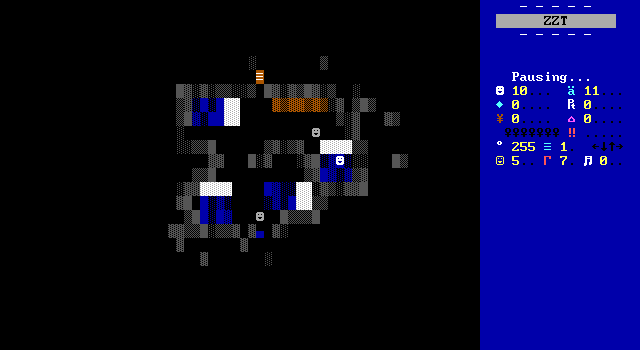
Despite Riley by definition having to be unharmed in the fight, he awakens in a decrepit building with a few beds to recover from his injuries.

Here he meets Star and Johnny. Johnny found Riley on the street and brought him to this place to patch him up. Star is relieved that he's okay, while Johnny thinks he's a bit of an idiot for coming to this neighborhood in the first place.
It's a shame to have the outcome of the fight ignored like this, especially when it would have been easy to force the player to lose by just having more thugs than bullets (easily done by not giving the player more ammo at the start of the outskirts). Fighting them wasn't particularly exciting. I'd take the consistency over getting to shoot a few objects any time.
Riley, having slept for a good... three-ish hours according to Star, gets right back to wanting to escape the city. Star asks if he has a pass, and Riley's forgetfulness comes back to bite him.
Star has a plan though. She also wants to get out of the city, and if Riley is willing to help her out, she believes that she can get them both out safely.
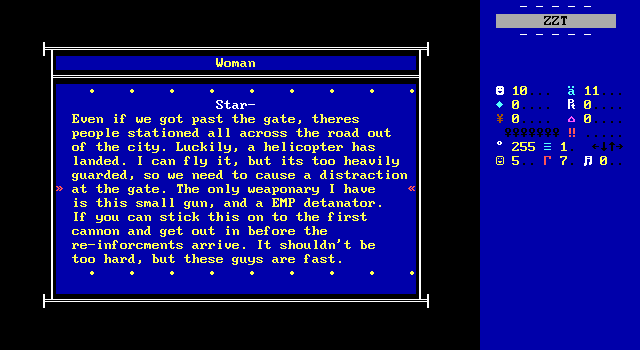
Thank goodness Johnny happened to be saved by a friend of a helicopter pilot with an EMP!
That icon in the center of the slums was in fact a helipad, forming the letter "H". If Riley can use the EMP to take out the laser cannons, he'll provide an opportunity for him and Star to slip off to the now occupied helipad, steal the helicopter, and fly away without fear of those anti-dog anti-air cannons shooting them down.
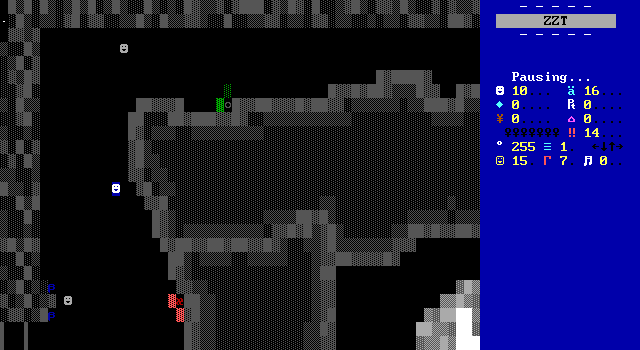
Fearing for his life, Riley agrees and the player is taken back to a copy of the outskirts board to plant the device.
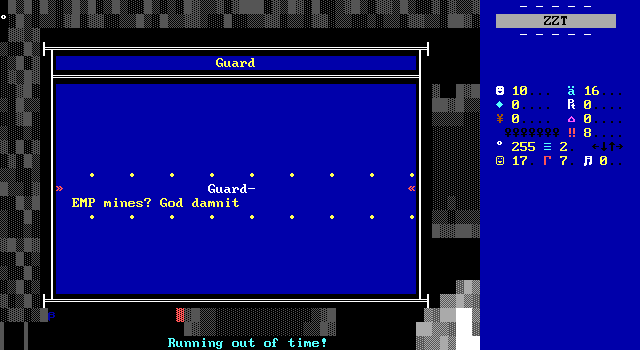

While it sounds like an intense plan, there's really no danger other than the time limit. Touching the cannons places the device and sets the necessary flag for the next player warp to kick in, allowing players to just ignore the guard entirely and be shot at whatsoever. While touching the guard does wake them up and cause them to give chase, they'll only fire if they're aligned with Riley. As the check for alignment is only made after every four moves, it's difficult to see a bullet ever be fired.
Instead, what should be spectacle, is nothing more than a joke in practice.
Fish also uses ZZT's own time limit feature to handle the limited window where the EMP can be placed and the helicopter hijacked. Since players only have ten health, this means another game over if you take too long. It also means that what I'm sure is meant to be an intense scene opens with ZZT playing its Jeopardy! jingle which really feels out of place for a game with this tone.
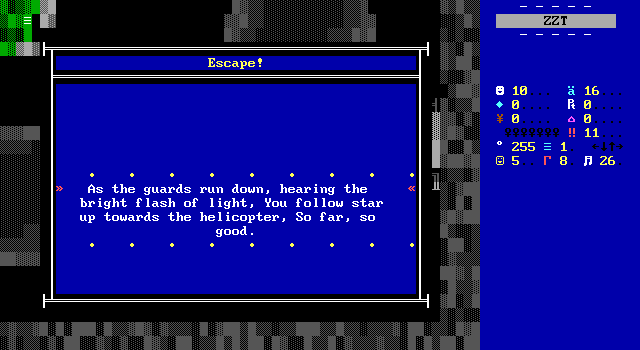

The next warp returns players to the lower right corner, this time on top of the bridge that leads to the chopper. There's one last race against a timer with no danger at all beyond it expiring.
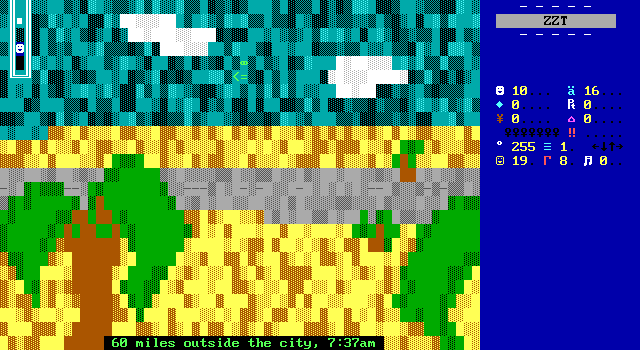
This board is a visual mess. Cool palm trees though. Less impressed by the helicopter which is the dinkiest little thing and has no animation whatsoever causing it to just sit perfectly still in the sky.
the sweetness...
from far away from that place. They can't
find me outside they city...They won't...
didn't you? Tell me about it, but not
right now, Were gonna have to land
near the service station, our gas
is almost out.
• • • • • • • • •
The game concludes with a celebration of the successful escape, and plans to... stop at a helicopter gas station? Well, good luck you two.

Perhaps the most intriguing thing about Twilight City is that it's very unclear what the rest of the world is like. Are we talking post-apocalyptic wasteland? Are they just going to fly to Chicago and chill there? It's very ambiguous, and without any other games actually set in this particular universe, the details are likely to remain unclear indefinitely.
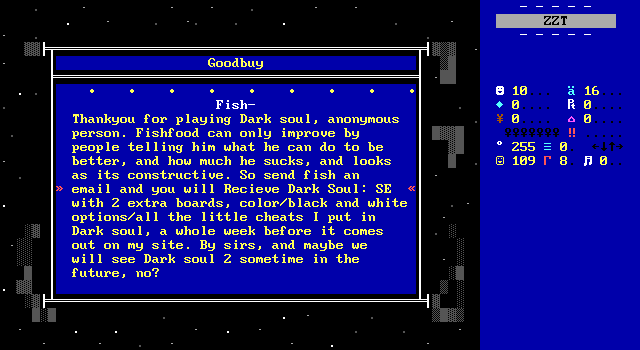
The actual final board mentions an alternate version, that I have to wonder if it was ever actually released. Having a "Special Edition" so soon after the original is a very unusual choice. The changes also seem very minor. I love the idea of an option for a black and white mode even if most of the game is already in shades of gray.
The idea of cheats is an odd one as well. There are really almost no points in the game where cheating would help aside from the cheats ZZT has built-in already for ammo, health, and time. What a strange thing to promise.
The only thing of note after the farewell text is to tell players that the game will now end in traditional FishIg fashion.
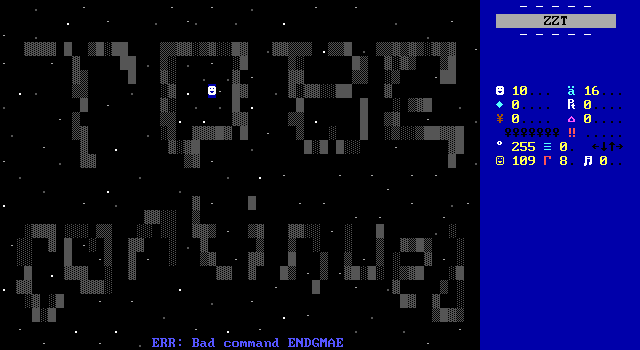
Which it does.
Final Thoughts
And that's Dark Soul! One of many teenaged ZZTer's attempts at writing some intense sci-fi drama that doesn't really go anywhere in particular. A game that FromSoftware apparently had no involvement in?
The game isn't all that bad as a whole, though every component leaves something to be desired. The game is not enjoyable to look at, suffering from black backgrounds as well as messy looking shading that makes it difficult to tell what you're supposed to be looking at. Environments are sparsely decorated, mostly relying on a dozen plants to add the slightest hint of color to any given board. Everything is very gray and brown, the curse of Super Tool Kit allowing players to use "accurate" colors for their buildings and office interiors.
The gameplay is lacking as well. For something described as an interactive cinema, it's not too surprising. Players rarely get to interact with anything beyond a line of text to clarify what they're touching. Many of the gameplay boards would be no different as cinemas beyond the speed at which players move through these spaces. The Floor 17 entrance hall, the subway station, and Riley's apartment after fighting with Mohr give players the ability to move around as they please, and do nothing to reward players that want to explore.
The action is limited to a single RPG battle that offers nothing to hold players' interests and a simple shootout with some thugs that plays like a less intense downtown from City of ZZT.
All that remains is the game's story, your typical evil corporation trying to off those who know too much. It's still not great, but as far as serious stories in ZZT go for the era, I can tell there was effort put into it. In particular, I was reminded of the later Ultima RPG, whose opening chapter also takes place in a crime ridden city where everything is dark gray and worn down. Fish commits to it though where Ultima and other authors were quick to deflect criticisms by having characters within the game comment on what was subpar about them. Everything here is played completely straight. No jokes are cracked about the absurdity of the situation, nor ZZT's own shortcomings when trying to tell a dark story where everybody smiles the entire time. Few ZZTers had the confidence to present their stories without pre-emptively catching the criticisms. A tactic that only served to draw more attention to their flaws.
While many authors simply assumed players would be invested in their worlds and characters simply by being told to, Fishfood seems to understand that investment can only be earned. He starts things off with a mysterious incident before players even see the game's menu. Coworkers have heard whispers about the incident and players can put together all their info to gain a better understanding of what likely killed Staton and the true reason the research labs have so many new members joining. Fish never says that Riley is meant to be timid, a badass, or anything really, letting opinions form based entirely on what Riley does within the game. Sometimes, he's kind of dense, like after the fight with Mohr. Other times, he's smarter than your average protagonist, trying to avoid violent confrontations with Mohr and Flint. The character having victories and losses and not needing to gloat or dwell on them really makes Riley unique in how mundane he is. For a game about an average guy thrust into a terrifying situation, Fish did a solid job with Riley.
Riley's own struggles with realizing just how deep this conspiracy runs combined with the intent for there to more games in the Dark Soul series put the character in a unique place where it's hard to say what to expect from him. He may very well have been planned to reveal Gene Inc. and bring them down, but with Twilight City being promised to return rather than Riley, it's just as likely that he won't survive this ordeal. Perhaps chapter two would see Star take the starring role with Riley being unable to survive after all.
As for the game's problems, they mostly come from trying to keep the game moving a little too quickly, leading to things like Owens showing up to Riley's apartment in the middle of the night, Riley's gun needing to be made useless for the duration of Flint's chase, and lucking into meeting a woman with access to EMP grenades and a pilot's license. These issues stick out, pulling back the curtain on a story that while hardly the most original, would otherwise be pretty respectable for the time. There are just a few too many moments where I found myself thinking things were too convenient.
I was quite surprised in the middle of my playthrough when I decided to check if the game had any old reviews that might provide an idea on how the community received it. While there are no z2 era reviews, hinting that the game never had a legacy (and with zero sequels, that's no shocked), I did somehow miss that Dark Soul actually won a Game of the Month award when it was released.
Reviewer Hercules describes the game as an "absolute masterpiece". It's easy to forget what the standards actually were back then. Especially for GotMs where the eligible games were limited to those released during a specific month. A slower month could give an average game better odds, but then again, "masterpiece" isn't how you describe a reluctant pick for an award[3].
Hercules praises the game for its spooky atmosphere, calling it one of the few ZZT games capable or being thrilling and even scary. He's not really wrong. Suspense in ZZT, especially back then, has never been an easy feat. Today the writing isn't strong enough to really get there, but it's not too hard to recognize the moments where Fish really is trying to go in that direction. The intruder at Riley's apartment, and subsequent reveal that it's actually Mohr and the sudden betrayal of Flint are two moments clearly meant to catch players off guard, taking the story in an unexpected direction. Nowadays, seeing Flint show up on the subway at four in the morning immediately made me suspicious of how much he could be trusted, but I suspect as a pre-teen playing this game on release, I'd be more excited for my buddy Flint to appear to join the escape.
Hercules goes on to describe the graphics as "professional", using dark colors to create atmosphere. That's just every ZZT game that used dark gray walls in the year 2000. He does at least call the RPG battle "nothing special", though at the same time, Owens showing up mid-fight was a genuine surprise to me more than two decades after this game was released.
Dark Soul overall didn't do it for me, but it didn't leave me with any regrets. There's enough here that I'd be interested to see what a sequel would have looked like. This is just yet another game that promised folks it would be worth it to stick around, and then never had anything to deliver. As an introduction to a series, Fishfood was on the right track, demonstrating a few surprises and letting characters establish themselves. With no follow up though, the only thing provided here is a tease at a storyline players can find easily enough elsewhere with brief intermissions for forgettable action and RPG sequences and a bit of walking through small rooms in a void. Maybe the next gaming universe will be one more worth visiting.
- [3] And it wasn't a particularly dire month (assuming the release dates are accurate enough that is). February 2000 also saw the release of Tseng's Gem Hunter Anthology filled with unreleased games and also a standalone upload the then-new Gem Hunter II: Special Edition. Plus Bramlage's second disc of Bloodlines, continuing where the previous month's Game of the Month winning disc one left off.

